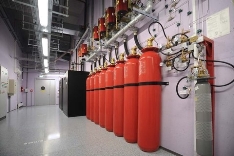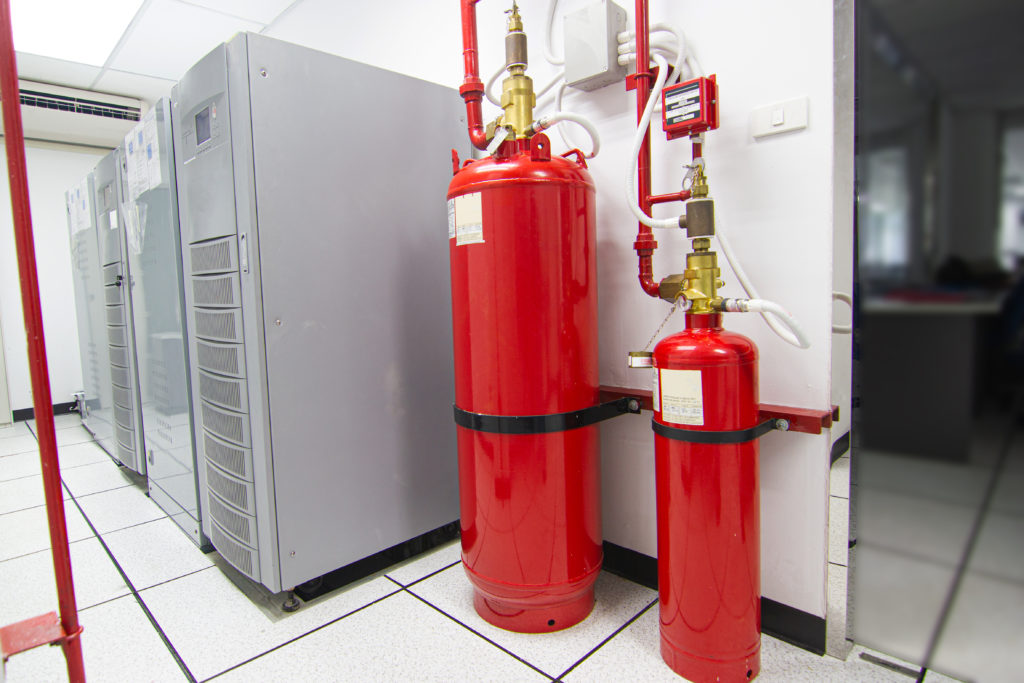Technical description of fixed firefighting system using NOVEC (FK-5-1-12) or FM 200 (HFC-227ea)
In the systems proposed by us, the extinguishing agents used are stored in specially designed containers located in or outside the protected premises. The gas fire extinguishing system is activated by smoke detectors located in the protected rooms in the main space, above the suspended ceiling and under the technical floor.
When activated, the system injects a defined quantity of gas into the main space, the space between the floor proper and the technical floor, and the space above the suspended ceiling through a system of pipes and nozzles.
The systems we propose have:
- Technical Approval
- Certificate of the National Institute of Hygiene
- Certificate of compliance
Extinguishing mechanism

Extinguishing agent NOVEC ( FK-5-1-12) and FM 200 (HFC-227ea) is characterised by:
- posiadają wysoką efektywność gaszenia,
- nie są klasyfikowane jako substancje niebezpieczne,
- są czystymi środkami gaśniczymi, nie pozostawiają zanieczyszczeń i osadów,
- nie powodują szkód w zabezpieczonych pomieszczeniach, zmniejszając problem strat,
- są skroplone pod ciśnieniem, dzięki czemu wymagają niewielkiej powierzchni składowania,
- nie przewodzą elektryczności, nie powodują korozji, przez co są bezpieczne nawet dla czułej elektroniki.
NOVEC and FM 200 are active extinguishing agents that cause very rapid extinguishing of flames through a combination of physical and chemical mechanisms. The physical factor of flame levelling is realised through heat absorption, which results in a decrease of the flame temperature and thus degrades the chain reaction occurring in the flame. NOVEC (FK-5-1-12) and FM 200 (HFC-227ea) also have a chemical effect by interrupting the chain reaction responsible for the spread of the fire. NOVEC (FK-5-1-12) and FM 200 (HFC-227ea) also has a chemical effect by interrupting the chain reaction responsible for the spread of fire.
Środek gaśniczy NOVEC (FK-5-1-12) to Perfluoro(2-methyl-3-pentanone) o wzorze chemicznym CF3CF2C(O)CF(CF3)2. Środek gaśniczy FM 200 (HFC-227ea) to heptafluoropropan o wzorze chemicznym C3HF7. W warunkach normalnych oba gazy są bezwonne i bezbarwne. Zarówno FK-5-1-12 jak i HFC-227ea dają się łatwo skroplić już przy niewielkich ciśnieniach, a po skropleniu zajmują małą objętość w porównaniu do stanu gazowego. Dla uzyskania lepszej charakterystyki wypływu dodaje się do butli, w których magazynowane są środki gaśnicze azot. Oba gazy składowane są w postaci ciekłej, a w momencie uwolnienia odparowują na dyszach i podczas wypływu równomiernie rozprzestrzeniają się w gaszonych obszarach. NOVEC (FK-5-1-12) i FM 200 (HFC-227ea) działają na poziomie molekularnym, powodując fizyczne schładzanie ognia – w styczności z płomieniem uwalniają ślady rodników redukujące reakcję procesu spalania. Środek gaśniczy FK-5-1-12 i HFC-227ea stężeniu koniecznym do gaszenia pożaru nie wykazują szkodliwości dla organizmu człowieka.
Novec (FK-5-1-12 – dodecafluoro-2-methylpentan-3-one) is a compound of carbon, fluorine and oxygen (CF3CF2C(O)CF(CF3)2) colourless, nearly odourless and electrically non-conductive. FM-200 is 7-fluoropropane, a hydrofluorocarbon derivative having the symbol CF3CHFCF3 – HFC-227ea. Fire-fighting action Novec and FM 200 is based on a combination of physical and chemical mechanisms that do not affect the oxygen content. People in the fire area where visibility is not restricted can see and breathe, and hence can safely leave the affected area. Due to its negligible toxicity, Novec can be used where people are present.
Toxicity of the agents Novec and FM 200 was assessed on the basis of test protocols approved by the US Environmental Protection Agency (EPA). The Important New Alternatives Programme (SNAP) of the EPA as well as the Hygiene Institute in Gelsenkirchen/Germany classifies Novec as an acceptable means of complete filling of rooms where there are human occupants.
Novec and FM 200 are clean gases and leave no residue. After fire extinguishing, expensive cleaning is therefore not required and shutdown times are kept to a minimum. Novec and FM 200 are not aggressive to most materials, such as steel, stainless steel, aluminium, brass and other metals and plastics, rubber and electronic components.
Safety of use
Both gases in the most commonly used design extinguishing concentrations are not dangerous to life and persons. The NOAEL value (No Observed Adverse Effect Level) denoting the extinguishing concentration level at which no symptoms of use are observed is 10% for NOVEC and 9% for FM 200, where LOAEL (Lowest Observed Adverse Effect Level) signifying the lowest extinguishing concentration level at which the symptoms of use are observed NOVEC was not recorded, while for FM 200 is 10,5%. Both values are higher than the most commonly used design extinguishing concentrations.
NOVEC ( FK-5-1-12) and FM 200 (HFC-227ea) are easily liquefied even at low pressures. After liquefaction, it takes up a small volume in relation to its gaseous form. However, during extinguishing, it flows out through nozzles as a gas and reaches places which are difficult to access without any problems. The fire extinguishing effect is obtained thanks to uniform distribution of the agent in the room during 6-10 sek.
In rooms protected by fixed gas extinguishing systems NOVEC ( FK-5-1-12) and FM 200 (HFC-227ea) pyrotechnics containing oxygen for combustion and chemically active metals such as sodium, potassium, magnesium, titanium, zirconium, uranium, plutonium and metal hydrides must not be stored.
Distribution
Both gases (depending on their application) are applied to the extinguished space through selected pipelines (diameters and lengths) and nozzles (diameters and areas of discharge openings).
Space-qualified quantity of gas NOVEC or FM-200gas assigned for the space protection, which is necessary to obtain the extinguishing concentration at the temperature of 18 degrees, is calculated according to its volume. Saturation of the protected space with extinguishing gas is even, and the arrangement of nozzles ensures proper filling of the entire volume.
Components of the gas extinguishing system

- containers for extinguishing agents,
- tank valves,
- electrical and manual operation of cylinder valves,
- cylinder pressure monitoring sensor,
- distribution pipelines extinguishing agent,
- extinguishing nozzles,
- calculation programme.
Gas cylinder for extinguishing system
Both NOVEC or FM 200 gas is stored in liquid form in steel cylinders charged with nitrogen to a pressure of approx. 42 barThe cylinder valve is equipped with a connection for mounting a sensor for checking the cylinder pressure, a manometer and a tear-off safety plate. In addition, each valve has a safety and protective cover to be fitted over the outlet port and trigger connection when the cylinder is not in operation. These covers are additional safeguards to reduce the possibility of uncontrolled, unintentional discharge of extinguishing agent, which could lead to life-threatening injuries and property damage.
Electric control heads
These heads are used to electrically actuate the valves of the extinguishing agent cylinders Novec or FM 200The head itself is actuated via the extinguishing control system, a remote trigger button or a manual trigger lever located at the control head. The control head is fitted directly to the cylinder valve of the extinguishing system. It has a connection for a manual or pressure trigger head, which can be fitted to the top of the electrical head.
Manually operated control head
This head is fitted with a trigger lever which is secured in the closed position with a safety pin. When the pin is removed the lever can be turned manually to the open position, which activates the appropriate valve and releases the extinguishing agent.
Outlet nozzles
Outlet nozzles 180° and 360° służą do zapewnienia prawidłowego wypływu
i rozdzielenia gazu Novec tak, by całkowicie wypełnić obszar zagrożony. Dysza 180° przewidziana jest do mocowania na ściany boczne, gdzie konieczny jest wypływ środka gaśniczego w kształcie półkola. Z dyszy 360° środek gaśniczy wypływa dookólnie. Stosuje się je w tych miejscach instalacji, w których dysze znajdują się w środku obszaru zagrożenia.
Zawór butli
Zawór butli posiada przyłącze do zamocowania wyzwalacza elektryczno-ręcznego lub czujnika do kontroli ciśnienia w butli, manometru i rozrywanej płytki bezpieczeństwa. Zawór wyposażony jest w pokrywę bezpieczeństwa i pokrywę ochronną, które stanowią dodatkowe zabezpieczenie, zmniejszające możliwość niekontrolowanego, niezamierzonego wypływu środka gaśniczego.
Elastyczny łącznik wypływu środka gaśniczego
Łącznik służy do połączenia zaworu zbiornika ze środkiem gaśniczym z kolektorem albo rurociągiem instalacji gaśniczej
Przewody rurowe
Środek gaśniczy do dysz rozprowadzany jest instalacją rurową. Przyłączenie zaworu do instalacji rurowej realizowane jest za pomocą łącznik wypływowy. Właściwe rozprowadzenie środka gaśniczego zależy od układu rur. W systemach gaszenia stosuje się rury stalowe, bez szwu, spełniające odpowiednie normy.
Złączki instalacyjne
Złączki muszą spełniać wymagania norm produktu oraz norm materiałowych i są przeznaczone do instalacji rurowych wysokiego ciśnienia, stosowanych w stałych urządzeniach gaśniczych. Złączki posiadają wytrzymałość mechaniczną testowaną przy ciśnieniu 300 bar.
Outlet nozzles
Dysze wylotowe 180° i 360° służą do zapewnienia prawidłowego wypływu i rozdzielenia środka gaśniczego tak, by całkowicie wypełnić obszar zagrożony. Dysza 180° przewidziana jest do mocowania na ściany boczne, gdzie konieczny jest wypływ środka gaśniczego w kształcie półkola. Z dyszy 360° środek gaśniczy wypływa dookolnie. Stosuje się je w tych miejscach instalacji, w których dysze znajdują się w środku obszaru zagrożenia. Stosowanych dysz nie wolno malować.
Manometr kontaktowy
Manometr służy do wskazywania ciśnienia w butli oraz wysyła impuls elektryczny do panelu sterowniczego w momencie spadku ciśnienia w butli o zadaną wartość. Posiada przełącznik kontaktowy i jest zainstalowany bezpośrednio na zaworze butli ze środkiem gaśniczym.
Side effects of the gas trigger
When releasing the gas Novec (FK-5-1-12) or FM 200 (HFC-227ea) the following side effects occur:
- Blast: - release of a large quantity of gas in less than 10 seconds causes strong currents. As a rule, other than scattered sheets of paper, no other side effects are noted.
- Higher pressure: the gas release causes a slight increase in pressure within the protected zone (to 400 Pa). For comparison, the resistance of a masonry wall is 1200 Pa.
- Limited visibility: - during gas release there is a limitation of visibility, especially near the nozzles, due to evaporation of the liquid agent (limitation of visibility depends on humidity).
- Noise: - the release of gas generates a lot of noise, although this does not cause damage to the hearing system.
Zapobieganie wahaniom ciśnienia podczas gaszenia
Wyzwolenie środka gaśniczego do przestrzeni chronionej skutkuje zmianami ciśnienia w tej przestrzeni. Zgodnie z obowiązującymi przepisami, konieczne jest przeciwdziałanie zmianom nadciśnienia i podciśnienia związanych z wyładowaniem gazu gaśniczego. W stałych urządzeniach gaśniczych realizowane jest to za pomocą wykonania odpowiednio dobranego otworu kompensacyjnego.
Aby zapewnić wymaganą dekompresję zabezpieczanego pomieszczenia, a jednocześnie odpowiedni czas retencji środka gaśniczego oraz konieczną szczelność obszaru chronionego na otworze kompensacyjnym instaluje się klapę odciążającą. Klapa ta, która w normalnych warunkach jest zamknięta zostaje odpowiednio wysterowana z centrali sterowania gaszeniem w momencie wykrycia pożaru. Centrala sterowania gaszeniem po wygenerowaniu alarmu II stopnia otwiera klapę odciążającą poprzez podanie napięcia na siłownik klapy. W momencie uwolnienia z butli środka gaśniczego centrala zdejmuje napięcie z siłownika, co powoduje zamknięcie klapy i uszczelnienie pomieszczenia. Podczas zamykania klapy, nadmiar powietrza który powstaje w wyniku wypływu środka gaśniczego zostaje wypchnięty na zewnątrz pomieszczenia przez otwór kompensacyjny, co zapobiega zmianą ciśnienia w gaszonym pomieszczeniu.